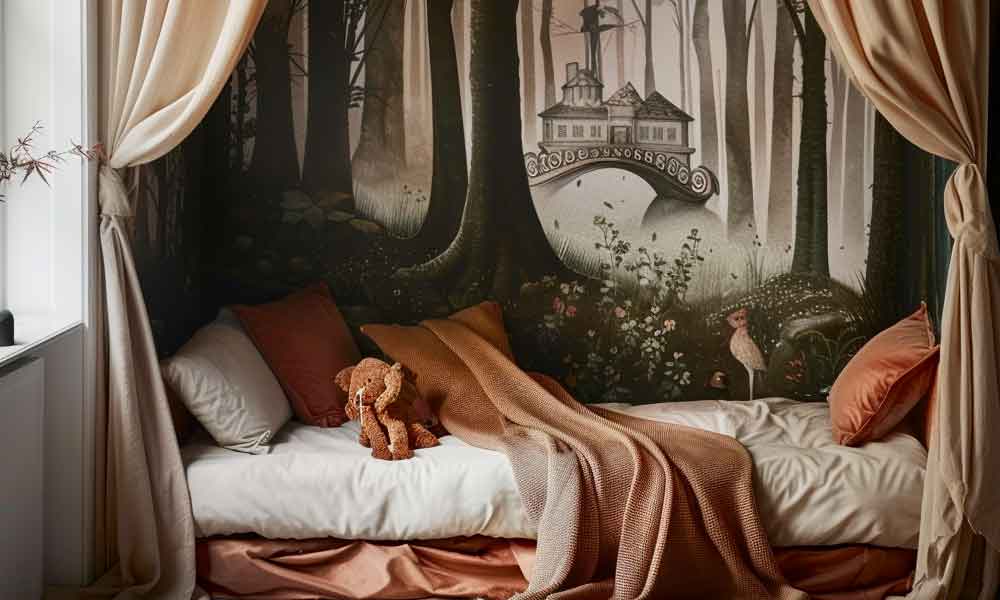Measuring & Fitting Included
Get an immediate price using our online estimator
Years’ of experience
Daytime, evening & weekend appointments
Call to speak to our call centre

Folklore-inspired interior design is a captivating approach that allows us to embrace the rich cultural heritage and traditional stories that have been passed down through generations. By incorporating elements of folklore into our homes, we can create spaces that not only reflect our personal style but also evoke a sense of nostalgia and connection to our roots.
Folklore is an integral part of our cultural identity, encompassing myths, legends, customs, and traditions that have been handed down orally for centuries. These stories often depict historical events, local beliefs, and the values and customs of a particular community.
By infusing folklore into interior design, we pay homage to our ancestors, their struggles, and their triumphs. It helps us preserve our cultural heritage and keeps these stories alive. Folklore-inspired interior design also enables us to create unique and authentic spaces that are deeply rooted in tradition.
Colours play a crucial role in folklore-inspired interior design. They can evoke specific emotions and convey a sense of cultural identity. Earthy tones, warm hues, and vibrant accent colours are commonly used in folklore-inspired spaces.
Patterns, such as intricate motifs, floral designs, and geometric shapes, are also prevalent in folklore-inspired interior design. These patterns can be incorporated into wallpapers, fabrics, rugs, and furniture upholstery to add depth and visual interest to the space.
In folklore-inspired interior design, natural materials are embraced to connect with nature and the environment. Wood, stone, and clay are commonly used to create a sense of authenticity and rustic charm.
Furniture made from reclaimed wood, hand-carved wooden accessories, and stone accents can bring a touch of the past into the present. Including these natural materials not only adds visual appeal but also promotes sustainability and eco-conscious living.
Handcrafted artefacts and decor pieces are essential in folklore-inspired interior design. These items contribute to the authenticity and storytelling aspect of the space.
Pottery, tapestries, woven baskets, and traditional handicrafts can be displayed as focal points, adding texture and a sense of history to the room. Each piece tells a unique story and creates a personal connection to the cultural heritage.
Folklore is often filled with symbolism and meaningful objects. Incorporating these elements into interior design can add layers of depth and significance to the space.
For example, you can include items like dream catchers, horseshoes, or talismans to bring luck and ward off evil spirits. These objects not only serve as decorative elements but also carry cultural and spiritual meanings.
Folklore-inspired interior design can also extend to the architectural elements of a space. Embracing traditional architectural styles, such as exposed beams, thatched roofs, or intricate woodwork, can further enhance the overall ambiance and create a harmonious connection between the interior and exterior.
Incorporating folklore-inspired interior design into your home can be a fun and creative process. Here are some ideas to get you started:
Research and Explore: Delve into the folklore and traditions of your own cultural background. Learn about the stories, symbols, and customs that resonate with you.
Choose a Theme: Select a particular folklore theme or story that captivates your imagination. It could be based on mythical creatures, legendary heroes, or significant historical events.
Colour Palette: Choose a colour palette inspired by the folklore theme you’ve chosen. Consider incorporating earthy tones, vibrant accents, or colours that hold cultural significance to create a cohesive and meaningful design.
Storytelling Wall: Create a storytelling wall by displaying framed artwork, tapestries, or photographs that depict scenes or symbols from the folklore. This can serve as a focal point and conversation starter.
Traditional Crafts: Support local artisans and craftsmen by incorporating handcrafted items into your decor. Look for pottery, textiles, or sculptures that align with your folklore theme.
Furniture and Textiles: Consider choosing furniture and textiles that showcase traditional craftsmanship or patterns inspired by folklore. Look for unique pieces that embody the spirit of the stories you wish to tell.
Personal Touches: Infuse your space with personal touches and family heirlooms that have a connection to the folklore or cultural heritage you’re celebrating. This adds a sense of authenticity and nostalgia to the design.
Storytelling Nooks: Create cosy corners or reading nooks where you can immerse yourself in the folklore-inspired ambiance. Use comfortable seating, soft lighting, and a collection of books or artefacts related to the theme.
Folklore-inspired interior design allows us to bridge the gap between the past and the present, enabling us to celebrate and honour our cultural heritage. By embracing tradition and infusing folklore into our homes, we create spaces that are not only aesthetically pleasing but also deeply meaningful. Whether it’s through colours, patterns, or meaningful objects, folklore-inspired interior design offers a unique way to connect with our roots and cherish the stories that have shaped us. So, why not embrace the enchanting world of folklore and create a space that tells your story?
What role do colours and patterns play in folklore-inspired interior design?
Why are natural materials important in folklore-inspired interior design?
What is the significance of handcrafted artefacts and decor in folklore-inspired interior design?
How can symbolism and meaningful objects be incorporated into folklore-inspired interior design?

With a keen eye for design Natalie is the Blinds Design Specialist at Custom Fitted Blinds. Dedicated to creating personalised solutions, she transforms spaces with creativity and expertise.
© 2024 All rights reserved
Made with ❤ with Elementor